Key takeaways:
- Automation enhances productivity and efficiency in manufacturing but raises concerns about job displacement and the need for workforce adaptability.
- Types of automation include fixed, programmable, and flexible systems, each serving different production needs and contributing to operational efficiency.
- Key benefits of automation include reduced production costs, improved product quality, and enhanced workplace safety through the use of automated systems for hazardous tasks.
- Challenges in automation encompass high initial investment costs, cybersecurity risks, and the need for effective integration and employee training to embrace new technologies.
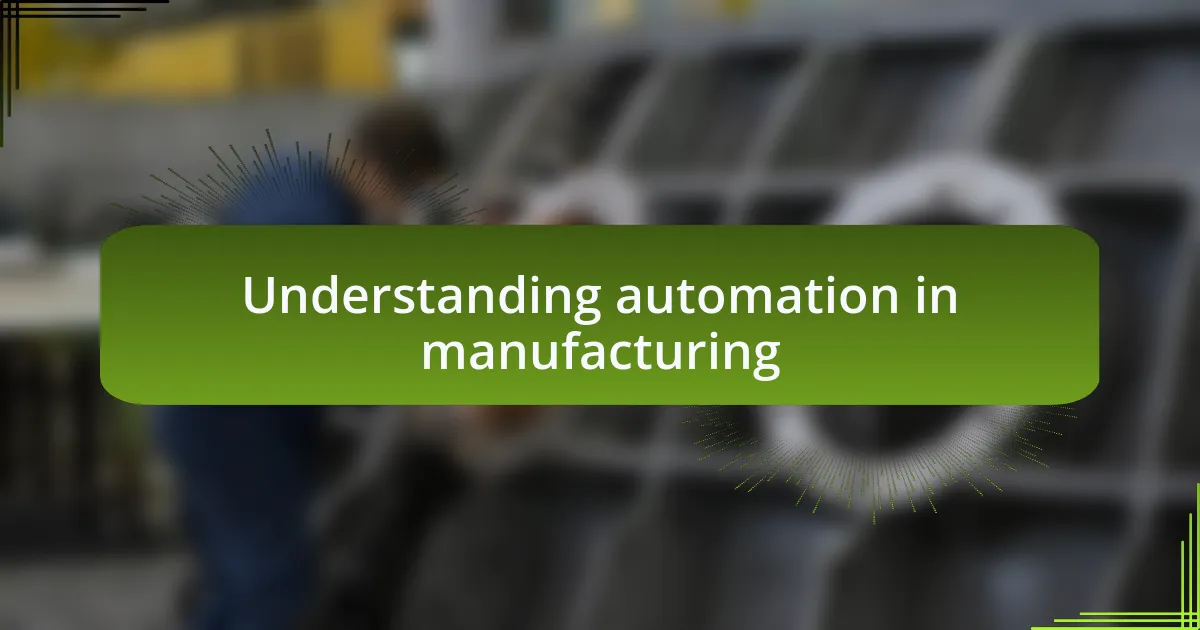
Understanding automation in manufacturing
Automation in manufacturing encompasses the use of control systems and technology to handle processes and machinery with minimal human intervention. I remember visiting a factory that had recently installed robotic arms on the assembly line. The precision and speed with which these machines operated left a lasting impression on me; it highlighted just how far technology has come in enhancing productivity and reducing human error.
When thinking about the impact of automation, I often wonder how it transforms the workforce. On one hand, it streamlines operations, allowing companies to produce goods more efficiently. Yet, on the other hand, it brings up questions concerning job displacement. I’ve seen firsthand how some workers adapted by honing new skills, while others struggled to find their place as technology evolved rapidly around them.
As automation continues to shape the landscape of manufacturing, it raises a crucial point of reflection: What does the future hold for industries that embrace these technologies? From my experience, the answer lies in balancing innovation with the needs of the workforce. A company’s success depends not just on its automated processes but also on ensuring that its employees are equipped to thrive in an increasingly automated environment.
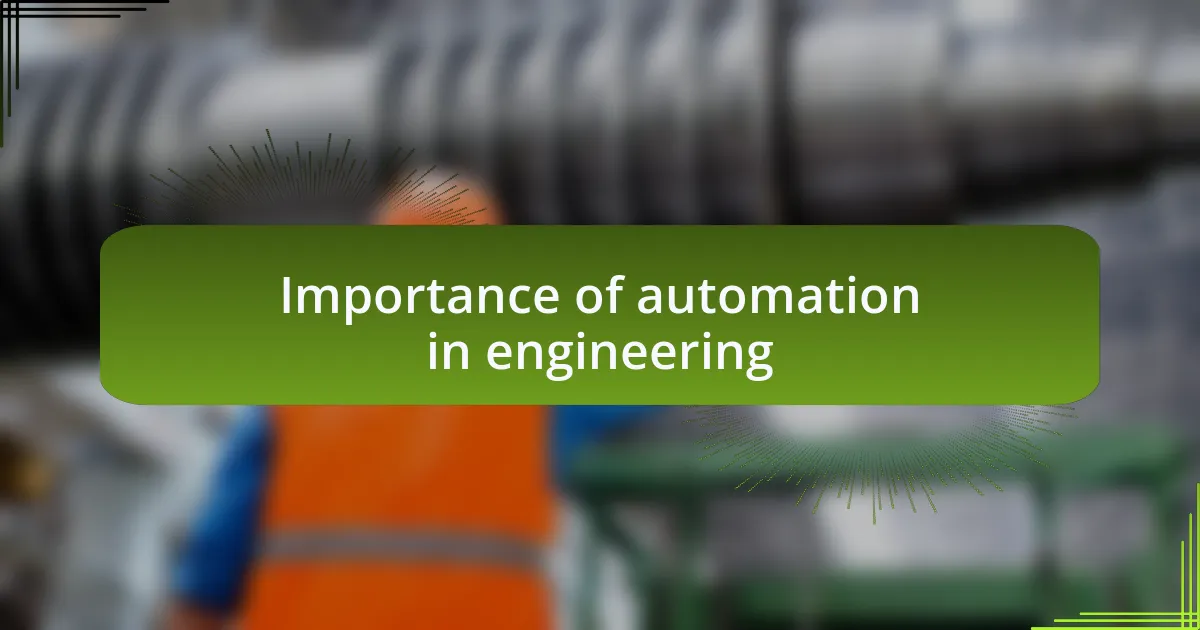
Importance of automation in engineering
The importance of automation in engineering cannot be overstated. I remember witnessing a production line where automated systems drastically reduced downtime during shifts. It was fascinating to see how this efficiency led not only to higher output but also to a decrease in operational costs. When engineers design systems with automation in mind, they’re essentially creating a foundation for sustainable growth.
One key benefit I often reflect upon is the enhancement of safety in the workplace. Automated machinery can handle hazardous materials and tasks, significantly reducing the risk of accidents. I recall discussing with an engineer about a plant that implemented automated cranes for heavy lifting. The sense of relief among workers was palpable, as they felt far less vulnerable to injury. Isn’t it incredible how technology can transform lives, making workplaces safer while boosting productivity?
Moreover, automation fosters innovation in engineering disciplines. As I watched a team brainstorm solutions around automated processes, I realized that these advancements allow engineers to focus on more creative aspects of design and problem-solving. They aren’t bogged down by repetitive tasks. Instead, they’re encouraged to push boundaries and drive the industry forward. How often does that happen in companies that resist automation?
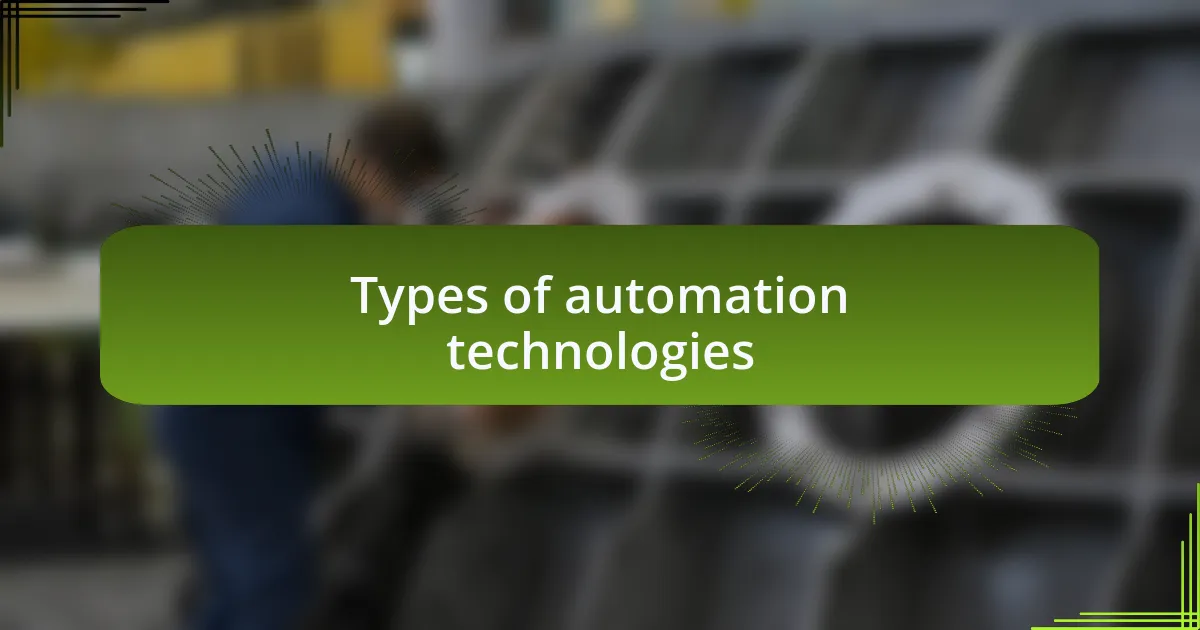
Types of automation technologies
When it comes to types of automation technologies, I’ve noticed there are primarily three categories: fixed, programmable, and flexible automation. Fixed automation is perfect for high-volume production. I once walked through a facility that used dedicated machines for assembling parts on a large scale. The rhythm of production was almost musical, and it struck me how such systems fit flawlessly into routine operations.
On the other hand, programmable automation offers the flexibility to produce smaller batches with varying specifications. I remember a project where a team integrated programmable robots into the assembly line. They could quickly switch tasks with just a few clicks, which eliminated downtime and allowed for rapid adaptation to new product designs. Isn’t it exciting to see technology that can keep up with market demands?
Finally, we have flexible automation, which truly stands out for its adaptability. I had a chance to observe a facility where robots were reconfigured for different tasks on the fly. The employees often commented on how empowering this was; they could respond to changing needs practically instantly. This level of customization in manufacturing not only enhances productivity but also fosters a sense of ownership and pride in the work being done. How could businesses thrive without embracing such versatility?

Benefits of automation for manufacturers
The benefits of automation in manufacturing are significant and often transformative. For instance, I recall visiting a manufacturing plant where automation reduced production costs dramatically. The company was able to allocate savings to employee training, leading to a more skilled workforce. Isn’t it remarkable how investing in technology can also benefit human capital?
Another benefit that really stands out to me is consistency in product quality. I once worked with a client who struggled with variations in their production line output. After implementing automated systems, their defect rates plummeted. The precision of machines over human effort can be a game-changer, don’t you think?
Moreover, automation can enhance workplace safety. I remember observing automated machinery that handled potentially dangerous tasks, which allowed employees to focus on more complex and less hazardous work. This not only improved morale but also emphasized a culture of safety. How often do we hear about accidents in the workplace that could have been avoided with better technology? Automating risky processes can protect lives while boosting productivity.
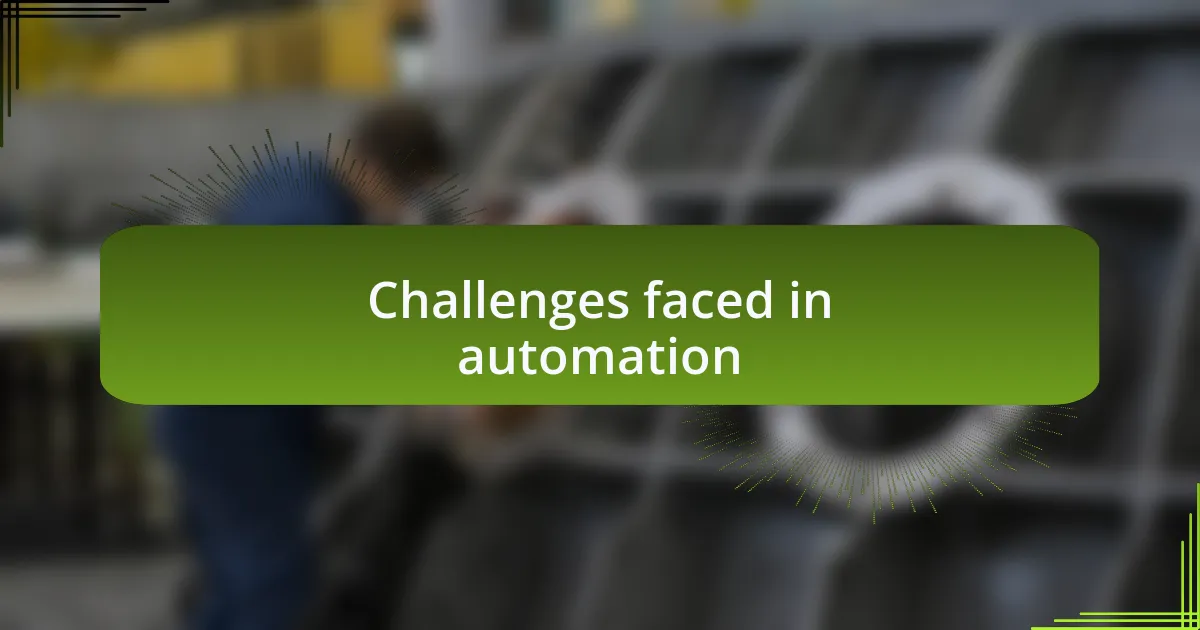
Challenges faced in automation
When discussing the challenges of automation, one major hurdle is the initial cost of investment. I remember a colleague who hesitated to automate their production line because they were overwhelmed by the high upfront costs. It really made me wonder—how can manufacturers justify such an expense when they’re unsure of the return on investment? This skepticism can stall progress and prevent companies from realizing the long-term benefits of automation.
Cybersecurity is another pressing concern that often gets overlooked. It’s fascinating to me how dependent we’ve become on interconnected systems, yet this leaves manufacturers vulnerable to cyberattacks. I once advised a facility where hackers attempted to infiltrate their automated systems. This incident made everyone realize that the benefits of automation can quickly be overshadowed by the risks of inadequate security measures. Isn’t it crucial for companies to prioritize their defenses against such threats?
Lastly, the integration of automated systems with existing processes can be more complicated than anticipated. I found myself in discussions with engineers who faced resistance from employees who were accustomed to traditional methods. Adapting to new technology can lead to friction among teams, and this brings up an essential question: how do we balance technological advancement with the human element in our workplaces? Emphasizing training and communication can make a significant difference in how smoothly this transition occurs.
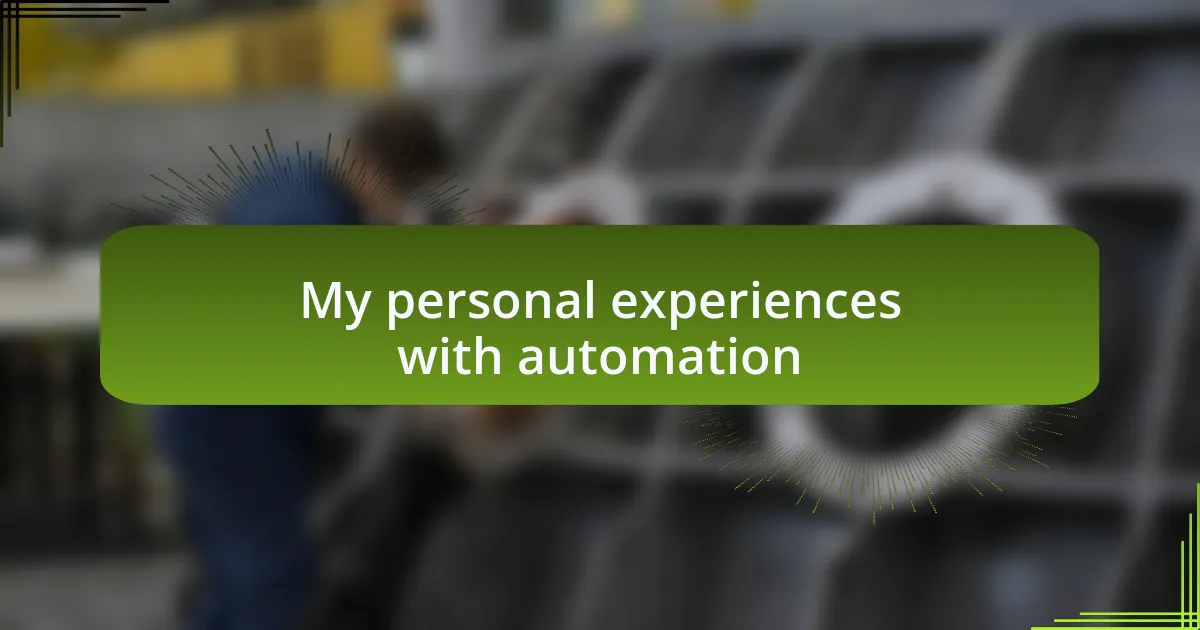
My personal experiences with automation
My personal journey with automation began quite unexpectedly when I joined a manufacturing team that was in the midst of launching a new automated assembly line. I vividly remember the initial excitement among my colleagues, but there was also palpable anxiety about job security. I even overheard conversations during breaks where people expressed fears about being replaced by robots. It made me reflect on how, at times, fear can overshadow the potential for improvement and innovation.
One particular project stands out in my memory: implementing a robotic arm to assist in a repetitive task. I was involved in the training phase, and I couldn’t help but feel a mix of pride and apprehension as I watched my teammates adapt. It was inspiring to see people who once doubted automation embrace the new process. Why do we often resist change when it can lead to more fulfilling work? That experience taught me how vital communication and patience are when introducing new technologies into an established environment.
Another defining moment was observing the efficiency gains firsthand. After the automated system went live, I was amazed to see the production rate double within weeks. However, it also led to a feeling of disconnection among some workers who longed for the camaraderie of manual labor. This duality made me ponder: how can we celebrate the benefits of automation while ensuring that the human element remains central to our operations? Balancing efficiency with emotional intelligence is a challenging yet rewarding aspect of my experience with automation in manufacturing.
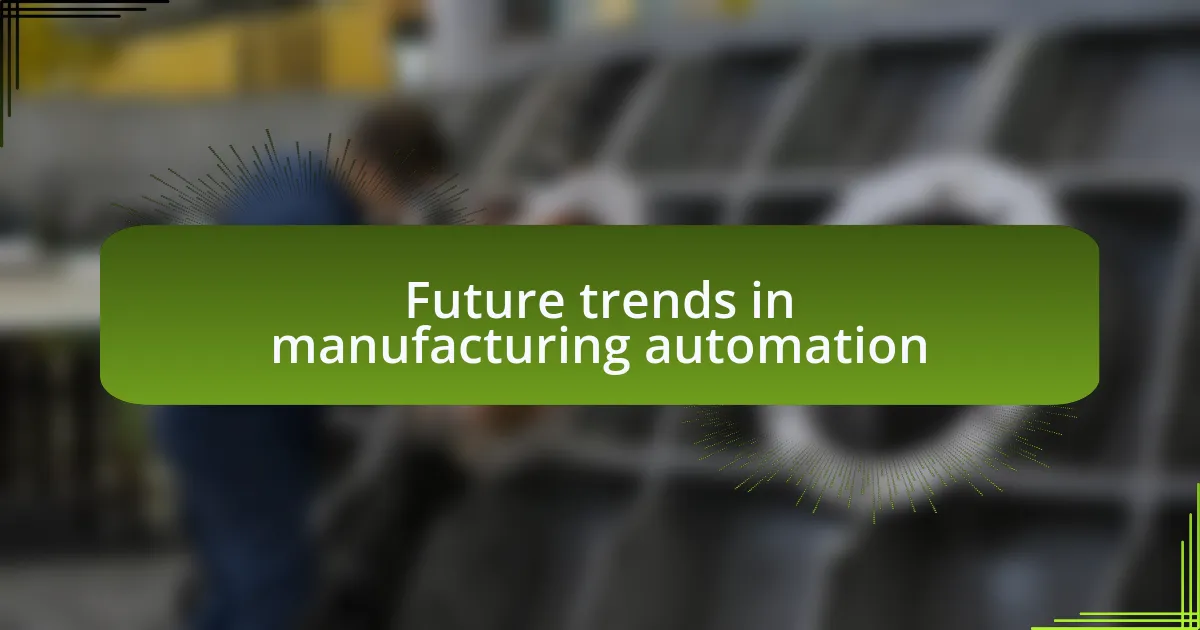
Future trends in manufacturing automation
As I look ahead, one of the most exciting trends in manufacturing automation is the rise of collaborative robots, or cobots. Unlike traditional industrial robots that operate in isolation, cobots are designed to work alongside human operators, enhancing productivity without replacing the human touch. Observing my colleagues team up with these machines has been a game-changer; it’s not just about efficiency—it’s about creating a supportive work environment. How might this dynamic redefine teamwork in manufacturing?
Furthermore, the integration of artificial intelligence (AI) into manufacturing automation is becoming increasingly sophisticated. I’ve witnessed how AI analyzes production data to optimize workflows, which was mind-blowing during my last project. It’s fascinating to consider: can machines not only learn but also predict issues before they arise? This proactive approach can significantly reduce downtime, allowing workers to focus on tasks that require critical thinking and creativity.
Sustainability is another crucial trend reshaping the future of manufacturing automation. I recently participated in discussions about implementing energy-efficient robotics and reducing waste via smart manufacturing processes. The question we often pondered was, how can we balance technological advancement with environmental responsibility? Embracing automation doesn’t just mean improving efficiency; it also offers the opportunity to lead the industry toward a greener future, benefiting both businesses and the planet.